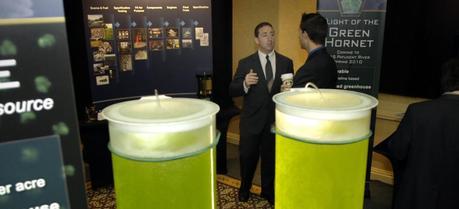 John Bigus, left, a fuels engineer assigned to Naval Air Warfare Center-Aircraft Division in Patuxent River, Md., explains the greening of Navy Fuels at the Naval Energy Forum 2009. Bigus stands in front of a display of camelina and algae fuels and processes for the production of renewable fuels to be tested in Navy ship and aircraft. (Credit: U.S. Navy photo by John F. Williams / Released)
John Bigus, left, a fuels engineer assigned to Naval Air Warfare Center-Aircraft Division in Patuxent River, Md., explains the greening of Navy Fuels at the Naval Energy Forum 2009. Bigus stands in front of a display of camelina and algae fuels and processes for the production of renewable fuels to be tested in Navy ship and aircraft. (Credit: U.S. Navy photo by John F. Williams / Released)Algae are interesting candidates for the large-scale production of biodiesel. Researchers at TU Delft have developed a way of finding the fattest and therefore the most suitable examples among all the many species of algae.
“The ultimate goal of our research is to make oil-producing algae as fat as possible, then press the oil out of them and finally produce biodiesel suitable for cars from this oil,” explains PhD student Peter Mooij of TU Delft.
A major threat to the stable cultivation of oil-producing algae is infection by other, thinner algae. One option is to use a sealed cultivation system and keep unwanted algae out of the system by means of sterilization. Although this is theoretically possible, it would be practically infeasible and extremely expensive to do this on a large scale.
“Our method is more suitable for large-scale algae production. We try to select for a particular characteristic and not for a particular species of algae. We are unconcerned whether species A or species B is used in our system, as long as they have the characteristic ‘fat’. So all algae are welcome in our system,” says Mooij.
Algae produce oil to store carbon and energy. Energy and carbon are useful to them during the long sunless periods or if it is cold. However, algae also need energy and carbon for their cell division and to extract nutrients such as phosphate and nitrogen from the water.’
Mooij took this fact as his starting point. “The principle works as follows: we go to the nearest pond and fill a test tube with algae. Back in the lab, we put the tube in a reactor. Then we provide the algae with light and CO2 during the day. This is enough for them to produce oil, however they are unable to divide. They need nutrients for cell division and we only give them these in the dark. To absorb the nutrients, they use energy and carbon. This means that only the fattest algae can divide, as they have stored energy and carbon during the day. By removing some of the algae every day, the culture will eventually exist of only the fattest algae; survival of the fattest!”
Using a test reactor, Mooij and his colleagues have now demonstrated for the first time that this principle really works.
Unfortunately, there is one important caveat, explains Mooij. “The survival of the fattest principle turns out to work beautifully: at the beginning there is a whole zoo of algae and, over time, the system does indeed almost become a monoculture. However, the fat alga is not producing oil yet. Algae do not produce only oil for energy and carbon storage, but starch too. Out test environment is selective where it concerns storage in general, but not yet for the specific storage of oil or starch. We will need to make the culture environment even more specific to achieve this. That’s what we are working hard at now.”
Another important factor to consider is the ability of algae to grow steadily, while resisting predators and temperature fluctuations. Earlier, we reported that scientists at University of Queensland’s Institute for Molecular Bioscience, in collaboration with Germany’s Bielefeld University and Karlsruhe Institute of Technology, have identified fast-growing and robust microscopic algae that could prove to be the key to cheaper and more efficient biofuel production.
Peter R. Mooij, Gerben R. Stouten, Jelmer Tamis, Mark C. M. van Loosdrecht, Robbert Kleerebezem (2013). Survival of the fattest Energy & Environmental DOI: 10.1039/c3ee42912a
